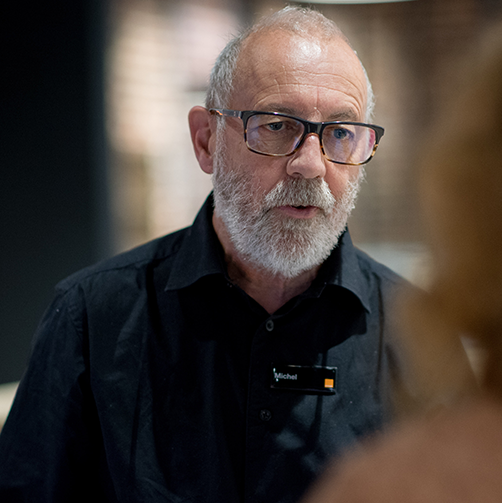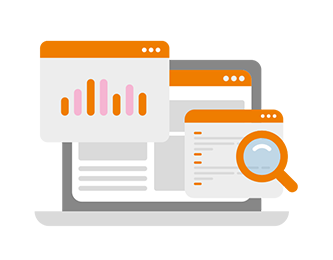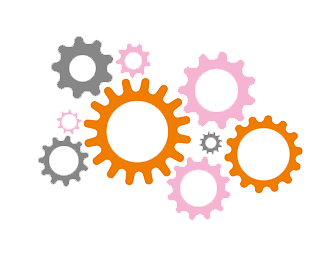Orange Polska creates value for its customers by providing a friendly and effortless customer experience. We do this by supplying unmatched connectivity, and by selling a broad portfolio of innovative convergent, mobile and fixed products and services, supported by a proactive sales force, outstanding customer care, and highly motivated employees. Satisfied customers provide the revenues and profits the Company needs to reinvest in the business, ensuring continued value creation for all our stakeholders.

Our business model is broadly unchanged compared to the previous Integrated Report As the climate neutrality is a challenge for the whole world and we are actively reducing our impact on the environment, we decided to add “Climate” to our natural resources.
External environment
Regulatory, Economic,
Telecom market, Supply Chain,
Social, Environmental
Internal environment
Corporate governance,
Corporate culture
Risk management
Orange Polska is exposed to a range of external and internal risks of varying types which can impact the achievement of its objectives. Therefore, Orange Polska maintains a risk management framework to identify, assess and manage risks. This framework has been based on the ISO 31000:2009 standard.
To be able to render mobile telecom services we require access to radio spectrum. The amount of spectrum that is at our disposal influences the competitiveness and quality of the services we render and ultimately the customer experience. This is especially important in the light of huge growth in mobile data consumption. Our competitive position in radio spectrum significantly improved in 2016 following completion of the relevant auction towards the end of 2015. As a result of the auction we acquired 10 MHz spectrum in 800 MHz band (the maximum that was allowed) and 15 MHz spectrum in 2600 MHz band.
In order to continue to assure the best customer experience we need to continuously optimise our effective use of spectrum. Taking into account growth of LTE data traffic and lower needs for 3G and 2G services, we decided to start the process of spectrum re-farming to newer technologies, with focus on 4G layer extension. Already in 2018 we re-farmed part of 900 MHz band from 2G to 3G, allocating twice more spectrum resources to 3G technology, while only small part of the bandwidth is currently dedicated to 2G services. We are also finishing re-farming of 1800 MHz and 2100 MHz to 4G. At the end of 2019 works were finished on 88% of LTE 1800 sites while 81% of sites with 2100 MHz equipment supported LTE2100. As a result of all changes the amount of spectrum dedicated to LTE/4G network capacity will increase by 38%. Re-farming also means that we are changing the model of cooperation with T-Mobile regarding 900 MHz and 1800 MHz bands from the one based on co-usage of spectrum (MOCN) to the one based on sharing infrastructure (MORAN). This means we do not share frequencies anymore, but thanks to optimization of all frequency resources, we can offer more capacity to our customers.
Future development of 5G services will require the acquisition of necessary frequency resources. It is assumed that three bands will be used for 5G network: 3.4–3.8 GHz, 700 MHz and 26 GHz. None of the above bands is available today. 3.4–3.8 GHz band will become available as first. The auction for those frequencies was announced as of March 6th and the allocation was scheduled to be done until end of June 2020. However due to COVID-19 pandemic it is likely to be delayed. Each winner of one of 4 available lots will be entitled to use 80 MHz of the spectrum for the following 15 years, There is still some (limited) legacy usage of auctioned spectrum thus actual spectrum availability will be differentiated for each spectrum block in each commune and will change in time. All spectrum winners will be obliged to start services in at least one Polish voivodship city still in 2020.
700 MHz band is currently in use by TV broadcasters and is required to be available by 30th of June 2022. However, the availability of this part of spectrum also depends on international arrangement with eastern neighbours of Poland, where this spectrum is used for digital and analogue TV and also for radionavigation (in Russia). Additionally model of the allocation of this spectrum remains unknown. There are ongoing analyses on the potential allocation of 700 MHz to the state-owned entity who would act as wholesaler (project #polskie5G).

26 GHz band can also be available after some rearrangements. Moreover changes to National Frequency Plan (Krajowa Tablica Przeznaczeń Częstotliwości) implemented in 2019 released part of 26.5-27.5 GHz for civil usage, while formerly this part pf spectrum was for military purpose only. It can be expected that allocation of 26 GHz spectrum will be no earlier than in 2021.
Current distribution of frequencies for the 700–2600 MHz bands and 3400-3800 MHz bands

* License for Cyfrowy Polsat Group (CPS) to use this block expired at the end of 2018.
Details of telecommunications licences are as follows:
| (in PLN millions) | Acquisition date |
Years to expiration (2) |
Net book value | |
|---|---|---|---|---|
| At 31 December 2019 |
At 31 December 2018 |
|||
| 800 MHz | 2016 | 11.1 | 2,266 | 2,471 |
| 900 MHz | 2014 | 9.5 | 228 | 252 |
| 900 MHz (1) | 2018 | 1.0 | 12 | 24 |
| 1800 MHz (1) | 2013 | 8.0 | 127 | 143 |
| 1800 MHz | 1997 | 7.6 | - | - |
| 2100 MHz | 2000 | 3.0 | 290 | 384 |
| 2600 MHz | 2016 | 11.1 | 87 | 95 |
| Total telecommunications licences | 3,010 | 3,369 | ||
(1) Licences held under agreements with T-Mobile Polska S.A.
(2) Remaining useful life in years as at 31 December 2019.
Network development driven by customer needs
Our activities with respect to network development are driven primarily by the needs of our customers. These needs are evolving along with the growing number of mobile devices, as well as the increasing popularity of cloud services, high-resolution videos, games and streaming platforms (in 2019, Netflix became the largest traffic source). In addition, our customers increasingly expect secure access to the digital world, with optimal quality and speed, at home, at work and on the move, regardless of technology and device (laptop, tablet, smartphone, TV). We believe that network reach and connectivity is one of the key criteria when choosing a telecom service provider.
To fulfil these needs, our network has to be widely accessible, reliable and safe. We operate by far the largest convergent network infrastructure (combined fixed and mobile networks) in the Polish market. That means we can ensure the best network connectivity.
The largest network infrastructure in Poland
As the former incumbent operator, we have the largest network infrastructure in Poland, supporting both fixed and mobile services. It includes around 15,400 km of fibre in backbone, 90,400 km of fibre in aggregation network and more than 443,000 km of access copper network. The access network is predominantly built in copper technologies; fibre accounts for around 56,600 km at the moment, although it is growing rapidly in line with our intensive fibre investment plans to be continued in the year 2020.
Fibre is also increasingly used to connect our mobile base stations, on one hand to boost capacity to accommodate growing data consumption and on the other hand to ensure greater reliability of the network. In 2019 additional 127 base stations were connected via fibre. At the end of the year, about 56% of our mobile base stations were connected to the backbone through fibre. Mobile and fixed networks share not only cable infrastructure but also higher network layers like core, control and service platforms. We will gradually transition our network to be fully IP-based in the years ahead, which will require the elimination of certain network elements (e.g. PSTN stacks).
Length of fibre access network (in ‘000 km) graph

Access network based on technological evolution, local approach and customer demand
To ensure the best connectivity and optimum resource allocation we take into account the specifics of local markets. In cities, we are focusing on the development of Fibre to the Home (FTTH) coverage, whereas in less populous areas, copper-based technologies, supplemented by mobile ones, are the primary broadband access solution. We also roll out our fibre network in smaller towns and in suburban areas on a selective basis, also within the framework of Operational Programme ’Digital Poland’ (POPC). Such a strategy stems from the very individual demand for fibre services in local markets. We are increasingly expanding our fibre network into single-family housing districts, though apartment buildings are still the primary target for our investments.
In the fixed network, we are continuing with an intensive rollout of fibre in line with our medium-term action plan. At the end of 2019, our fibre access network covered 4.2 million households in 142 cities and towns.
In the mobile network, thanks to LTE800 rollout based on frequencies purchased in 2016 and earlier Investments in the 1800 MHz layer we were able to ensure almost 100% coverage with our 4G network. In response to the growing demand for high-speed internet access, Orange Polska is also steadily increasing the number of locations supported by LTE Carrier Aggregation technology (4G+), which multiplies available bandwidth.
Network reliability and resilience requires the constant upgrade of self-healing network mechanisms and continuous quality monitoring. We are capable of monitoring service quality not only at the statistical level but also from the perspective of an individual customer. We are proactive in our approach and respond before parameters start to deteriorate, preventing network congestion, thus ensuring the same connectivity experience, whether customers use our mobile or fixed networks.
Preparations for the 5G launch in Poland
Over the coming years 5G technology will gain in importance. In 2019, the Telecommunications Law was amended. The key changes include: enabling the President of the Office of Electronic Communications (UKE) to announce an auction or tender with respect to frequencies for which licences have not expired yet, but are to expire soon, and changes aimed to ensure the efficiency and effectiveness of auction or tender procedures. As a result of these changes, the bandwidth allocation and, consequently, the 5G network launch can be conducted much earlier (the latter could happen immediately upon the expiration of the current licences).
In the beginning of 2019, the President of UKE carried out initial informal consultation on an auction dossier for 3400–3800 MHz frequencies, which are the key band for the first stage of the 5G roll-out and the primary carrier for this new technology in urban areas. In subsequent months, the President of UKE made intensive efforts to withdraw the rights to use this spectrum from the entities which do not use the allocated frequencies and radio licences in any way. As a result, the frequency blocks offered in the auction will be free of geographical or time constraints as much as possible. In the autumn, discussions with operators on the possible technical conditions of using the spectrum were initiated. Thanks to the aforementioned actions, in early December, an auction dossier for four frequency licences in the 3400–3800 MHz band, 80 MHz each, was released for consultation. The consultation was completed on January 10, 2020. The auction for those frequencies was announced as of March 6th and the allocation was scheduled to be done until end of June 2020. However due to COVID-19 pandemic it is likely to be delayed. Each winner of one of 4 available lots will be entitled to use 80 MHz of the spectrum for the following 15 years. There is still some (limited) legacy usage of auctioned spectrum thus actual spectrum availability will be differentiated for each spectrum block in each commune and will change in time.
Orange Polska ready to launch 5G services as soon as it obtains the required licenses
It is our ambition to actively participate in the implementation of Poland’s 5G network in order to provide our customers with access to this network and modern services based on it. We have continued our preparations for 5G launch. The ongoing intensive rollout of our fibre network is a precondition for the efficient operation of the future 5G mobile network. In the beginning of 2019, Orange Polska conducted 5G tests in Zakopane, using 26 GHz frequencies, on which 5G services of fibre-like capacity are to be based in the future. In the Orange Cities project, which has been carried out since September, Orange Polska started extensive tests of the 5G technology in Warsaw and Lublin, using the 3.5 GHz band. The test 5G network comprised 19 base stations and used network equipment from various suppliers. A total of over 100 different terminals (handsets, routers) were used, and both journalists and our customers were invited to take part in tests.
Apart from hardware tests, Orange Polska has been actively involved in discussions about future bandwidth allocation plans, coming up with initiatives aimed to ensure quick and effective 5G spectrum allocation.
Growing customer demand for cybersecurity
As far as network cybersecurity is concerned, the year 2019 acted as the CyberTarcza (CyberShield) year. Over 2.5m blocked botnets’ command&control connection attempts. The significant increase in security incidents in the on-line economy has led to growing customer interest in cybersecurity services. We have introduced the CyberTarcza in a mobile version for our customers. Orange Polska’s Computer Emergency Response Team (CERT) operates around the clock, taking care of all cybersecurity issues that impact users who access the internet through the Orange Polska network. For the 2019 our cyber threat rapid response team has grown even more into national cybersecurity ecosystem with its activities being widely regarded.
Anticipating the future cybersecurity trends we joined – playing an important role – EU-founded science project SIMARGL (Secure Intelligent Methods for Advanced Recognition of Malware and Stegomalware). As for now on, working in 7 countries, 14 various entities environment is a unique opportunity for growth and knowledge exchange leading to the common goal – for the ordinary people to feel secure online.
5G network security
Discussion on 5G network security, in particular in terms of the use of devices offered by Chinese suppliers, is an important factor related to the implementation of the new generation of wireless networks. Key players in the global arena are involved - in particular the USA, China, as well as the European Commission and European Union member states.
At EU level, work was undertaken in 2019 to define a common approach to 5G network security, including a 5G risk assessment process and major risks identified in the 5G network. These works were concluded in a document published on 29/01/2020 entitled “Cybersecurity of 5G networks - EU Toolbox of risk mitigating measures”. It does not explicitly exclude or prohibit any supplier, however the dependence on one supplier, as well as risk associated with the supply chain, including the activities of other countries, were considered a significant risk.
It is also foreseen for Member States to carry out risk profile analysis and to introduce possible restrictions and exclusions especially for key resources. Member States by 30 April 2020 should submit to the European Commission specific actions they will take to implement the assumptions of the “toolbox”. At the same time, with the adoption of the EU Cybersecurity act, work has begun on defining European cybersecurity certification schemes and issues related to the certification of 5G network elements are being considered as candidates for such certification.
Work in this area is also carried out at national level, which is reflected, among others, in signing the Joint US and Poland Declaration on 5G, as well as initiating legislative procedure on drafts of the ordinance of the Minister of the Digital Affairs on technical and organizational requirements regarding the security and integrity of network and services, as well as on the draft ordinance of the Council of Ministers on the telco operator action plan in cases of significant threats.
Draft ordinances do not provide for exclusion of any supplier and focus on avoiding dependence on one supplier and verification of supply chain security. Thus, currently no restrictions have been introduced in Poland regarding cooperation with various suppliers in the implementation of 5G networks.
The potential introduction of such restrictions in the future would however involve the risk of limiting the pool of telecommunications equipment suppliers, and thus could affect the plans for the construction and development of network infrastructure (including 5G). This may affect the delay and/ or increase the cost of implementing 5G networks, as well as reduced customer interest in Chinese brand products.
Network efficiency
To increase the efficiency of our infrastructure, legacy technologies and solutions which are mainly voice-oriented are being replaced with a converged network capable of handling all types of traffic: voice, data and video. We implement solutions that fully support IP technology, and, thanks to self-healing and dynamic reconfiguration mechanisms, provide for higher service quality while improving cost-effectiveness thanks to massive deployment of 100Gb/s technology. In our efforts to provide customers with the best network in Poland, we leverage our own investments by using third party infrastructure and benefiting from EU funds for network construction.
On the mobile side, we cooperated with T-Mobile to set up NetWorkS!, a company responsible for network construction and operation. We share sites infrastructure (over 10,000 shared sites), which enabled the fast introduction of 4G and optimization of operating costs and capital expenditures.
In areas where we are planning to upgrade our network to high-speed, we are also using modern third party infrastructure to supplement our own investments, if a reasonable commercial arrangement can be made. In 2019, we signed further such agreements, which extended coverage of our VHBB services by over 260k households.
We participate in the national Operational Programme ’Digital Poland’ (POPC). Between 2014 and 2020, POPC is implementing EU Digital Agenda objectives in Poland and providing EU funds to support network construction in areas where standalone commercial investment is not profitable. That will allow us to upgrade our network to high-speed capabilities in less densely populated areas.
Orange Polska is now carrying out projects won during the second POPC competition stage. These include the supply of fast Internet connections (at least 100 Mbps) to 423 municipalities. In the 2019 OPL connected ca. 2,000 schools to fibre. At present Orange Polska continues connecting households which constitute large part of the contract with governmental institutions.

We aim to meet the needs of our customers by delivering unmatched data connectivity and products and services that matter to them. We want to be the number one operator for Polish households and the trusted partner of choice for businesses, supporting digital transformation. We offer a broad portfolio of telecommunication products and services for individual, business and wholesale customers. We are the biggest fixed-mobile convergent operator in Poland, offering fixed connectivity based on different technologies. Our success as a business depends on delivering value to all our customers, enabling them to fulfil their needs and aspirations. This translates into increased market share on the one hand, and on the other hand into revenues and profits. To achieve success we have to design a palette of services that fit customer needs, are competitive and allow us to differentiate ourselves on the market. Finally, the offer has to be properly communicated.
Fitting customer needs
As customer needs are evolving rapidly and the continued digitisation of society generates a vast increase in demand for data transfer, we have to constantly develop our offer, adjusting it to customer needs and providing the right products at the right price. Our activities in this respect are different for the mass consumer market and for business customers. Furthermore, the business customer group is not homogenous either. We make a distinction for internal purposes between small businesses, bigger corporate customers and the largest customers (key accounts). An example of a change in customer needs is the trend towards fulfilling the digital needs of entire households, as opposed to the single service contracts that were the market standard a few years ago. Our products are available to all our customers regardless of their age, ability, skills or place of residence. We conduct an active dialogue with our customers to ensure that our services and products meet the relevant needs and requirements.
Competitiveness and differentiation
In order to be successful, our service portfolio must be competitive. So we very closely monitor the activities of our competition and react appropriately. The Polish market is very competitive with a significant number of players in all its segments. The level and dynamics of competition have had a very significant influence on our financial results. We are constantly looking for innovations in our product portfolio and the right balance between features and price. The key differentiator and the source of competitive advantage for us is the ability to offer both mobile and fixed services, which we call convergence. By addressing the household’s telecommunication needs in a comprehensive manner and encouraging customers to buy additional services, convergence increases customer satisfaction and reduces churn as compared to single service users. We accelerated our convergence strategy by introducing the Orange Love convergent offer and making it the key commercial formula in the Orange.one strategy. We also launched a highly innovative Orange Flex offer, fully manageable from a smartphone application. We believe total flexibility and digital experience will be the key factors for telecommunications services customers in the future. We also develop adjacent services that complete our basic telecom product portfolio for a household, like energy resale. On the business market a good example of differentiation strategy is our development of competencies in ICT, which in a lot of cases helps us to win business in our core services. Our global and widely recognised Orange brand is a vital source of competitive advantage and also helps us to differentiate.
We aim to make it easy for our customers to access our products and services. We use different channels to connect with customers, including traditional points of sale (our own or our agents’), online, telesales and door-to-door. To maximise value generation we must ensure the right mix of distribution channels, reflecting market evolution, local specifics, customer needs, our competitors, and the range of services we offer.
More effective selling with a local approach
The Polish telecom market is heterogeneous: households are divided fairly equally between big cities, small towns and rural areas. Each of these three zones is different with respect to factors such as competitive environment, our market shares in particular segments, connectivity options and customer needs. We diversify our sales approach to match local expectations and needs as well as customer purchase history. This allows us to reach them with an appropriate offer, through an appropriate sales channel.
For example, in the competitive Warsaw market we run special digital campaigns and dedicated cross-channel actions to generate traffic at points of sale. These actions have proved effective and resulted in good sales results. In sales outlets we meet with customers who need assistance in choosing an offer; for time-sensitive customers we offer telesales; while those preferring to make decisions based on the complete information set and extensive price comparisons can choose to purchase online. This approach allows us to adapt to customer expectations, better recognise the potential of local markets and more effectively adjust our network investments to local demand.
Digitalisation and cross-channel
When it comes to getting the right mix of sales channels, our strategy is primarily driven by two elements: evolving customer purchasing preferences and the need for internal efficiency. We carefully monitor cost-to-revenue ratios. One obvious trend is the growing importance of online sales. On our website, we continue to enhance personalisation: customers are presented with dedicated content depending on their actions and the services they use. We also create a positive user experience across all customer touchpoints with innovative customer communication tools, such as:
- Bot-messenger – enables our customers to communicate in a near-natural language via applications such as Facebook Messenger
- Max - a voicebot which allows customers to get support on simple topics - it provides information about payments, allows them to report failures, calls back with an invoice payment reminder if necessary, or sends an SMS with payment information on request.
In 2019, the popularity of the My Orange application continued to grow. Currently, about one million customers within our network log on to it every month. This is 15% more than in the same period last year. The number of orders placed through the application in 2019 increased by 30% compared to the previous year. Already over 30% of purchases in the My Orange application are carried out via the “One Click” process, which enables the extension of an agreement or purchase of a new offer within the application. The value of pre-paid top-ups made within the My Orange application over the last year has doubled.
Customers demand the same quality of experience regardless of distribution channel: face-to-face, by phone or online. To address this, we have developed an omnichannel approach. Despite the growth of online sales, traditional points of sale still retain their importance. POS accounted for almost half of total sales in 2019, and we expect a similar ratio in the coming years. Increasingly, we see customers hopping between these channels: they may start a transaction online but finalise it in a shop, or vice versa.
In 2019 we continued the Best Retail Network project. Our ambition is to bring all of our outlets in line with this concept by the end of 2022. Solutions previously only implemented in the large Smart Stores, such as intuitive and functional interiors, are also being implemented in smaller stores to meet customers’ needs.
Main features of the Best Retail Network project:
- high availability of livedemo
- wide portfolio of accessories
- dedicated zones (eg. home zone)
- digital signature
At the end of 2019, 33% of our stores had already been modernised in line with the new concept (235 stores).
Based on shop size we have divided our outlets into three categories:
- Smart Stores – the largest modern flagship showrooms located in Poland’s biggest cities
- Standard – large outlets in big cities, mostly operated by Orange Polska
- Compact – small outlets in medium to small towns, operated by agents

Delivering top quality customer care remains our priority. We want every customer interaction with Orange to be positive, so we make sure that all our activities are aimed at improving the customer experience. We use the proven customer journey management methodology within the Orange Group on a daily basis in order to ensure a uniform and consistent experience with Orange, regardless of the contact channel chosen by customers.
Mix of friendly contact channels
We know how important it is to adapt the available contact channels to the preferences of our customers. Therefore, we try to respond to their constantly evolving needs, ensure the best quality and standards of customer care, and use cutting-edge technologies to increase cost effectiveness. In 2019, we focused on the rapid development of digital channels and constant improvement of traditional channels.
We prioritised our voicebot, Max, and My Orange in the development of digital channels. My Orange is both a mobile app and an account available on our Orange.pl website, which provides customers with service information and management functionalities. My Orange enables customers to quickly and easily check their credit balance, activate or deactivate services and review details of fees and charges on their own. In 2019, a million more customers used My Orange than in 2018. The Customer Effort Score Online, a metric tracked by Orange which measures the percentage of customers who could easily or very easily resolve an issue, was up 5.3 percentage points, year-on-year.
Our customers have begun to benefit from our successful implementation of sophisticated service channels based on artificial intelligence (AI).
- Since 2019, our customers have been supported by Max, the AI voice of Orange. Max answers 100% of calls to our service infolines. It can effectively advise customers how to resolve an issue on their own or, in case of more complicated matters, quickly and efficiently transfer a call to the right consultant.
- Our customers are increasingly using chat functions. In 2019, out of all conversations with customers via Orange chat, almost 20% were supported by chatbots. Furthermore, at the end of the year, we launched our first AI-based chatbots, which can even better adapt to the preferences of our customers.
As for improving traditional channels, our priority was further standardisation and related improvement of service quality in the process of the COPC (Customer Operations Performance Center) certificate implementation. We are the only telecom provider in Poland that has been operating in compliance with the global COPC standards for a number of years. The COPC certificate attests to the highest quality in customer care management, particularly with regard to efficiency monitoring, quality, and employee recruitment and development.
As Orange Polska’s customers frequently choose newer digital means of communication, in 2019 we expanded the scope of COPC certification to include digital channels. We comply with these standards in all our contact centres.
Mix of friendly contact channels

- Orange.pl
- My Orange online account
- My Orange mobile app
- Our Orange community
- Social media, such as Facebook and Instagram
- Chat
- Voicebot with artificial intelligence (Max)
- Chatbot
- Web applications for business customer self-service*

- IVR**
- USSD***

- Call centre
- Point of sale
- Delivery courier
- Field technician
-
*
Premium Support Portal and Fleet Manager – are free self-service systems for B2B customers, enabling them to submit requests, verify data, view invoices and manage agreements.
- Premium Support Portal is a system dedicated to Fibre Business Package, Business Package, data services and advanced services.
- Fleet Manager is a system dedicated to mobile services.
-
**
IVR – Interactive Voice Response. A system allowing interactive caller support. The caller, after hearing the recorded messages, selects the chosen items from the menu.
-
***
USSD – Unstructured Supplementary Service Data. After choosing the selected menu on the handset screen, the customer activates another menu that includes the information they need. The menu is visualised on the screen (if the phone has one).
Customised service
We customise our service to the needs of various groups of customers:
- Senior citizens (over 65)
- Young customers
- Customers with disabilities
- Fibre service customers
- Premium customers
Upper-tier business customers are offered dedicated and personalised customer care.
As a result, we can handle customer matters much better, aptly adapting to the customer’s age, individual needs or required access features.











